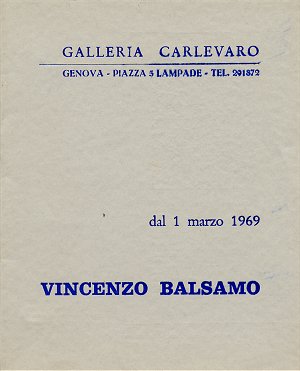at "Carlevaro" Gallery , Genova, March 1969, ed. "Carlevaro" Gallery. |
||
"Not available-out of print"

at "Carlevaro" Gallery , Genova, March 1969, ed. "Carlevaro" Gallery. |
||

|
I have been following Balsamo's painting and his slow but
certain evolution, towards shapes more and more perfect, since his
first exhibition in Rome. What I admire in this painter, who is not very young and not old
enjoy choral praise from triumphant critics, is the stubborness with
which he walks on the road where his vocation directed him; after
all he is self - taught. No one taught him how to hold a brush in his hand or to
elaborate the impasto. What he knows and does derives from the
interest he shows towards things: nature, objects, social
phenomena, human personalities. All his painting from the distant ( and maybe now disowned)
age of the street musicians (he met so many of them in Apulia) to
the present landscapes and still lives whisch show different aspects
of the second season of his life, between his home in Rome and
the frequent journeys north, is the careful, detailed, painstaking
diary of his curiosity, the curiosity of a traveller. Sun and fog, warmth and mists are mingled and juxtaposed in
the range of his production as the different aspects of the same
principale closed in the context of a production whose main
defect, if we really want to notice it, lies in a certain indulgence
towards storytelling. But it is not granted that this insistence is always a sin, especially
if we deal with a painter who has taught himself with great will and
sel - discipline without any mark of pedantry. I could say that Balsamo transforms his imperfection, at a
certain point, in loving, almost passionate, compliance: it is the
subsidence of the Mediterranean civilization (seen as a matter of
customs and development of traditions) which unleashes in him the
violence of the reds, dimmed, however by the dark blue colours
which are - both of them, I mean - the alternative affered by our
southern character to the phenomena of existence. The antithesis is
inside us: it was born with us and manifests itself in the changeable
play of events. Who, more then a Southerner can be merry and
sad at the same time, be an optimist and deny all hopes? Look for Balsamo's painting here and you will find it: entire, complete, absolute, readable: above all. This is not a small matter in these times, so full of allurements but also of tricks and ambiguity. |
His landscape are sometimes based on a sort of naturalism
I could call brutal, so devoid of sentimentalism are frames and
the stresses, and some other time they are almost abstract
in the tangle of lines and tones where the painter, following his
inspiration, has almost drowned, forgeful of reality,
seduced by the arabesque which came to life under his brush;
these are effects of original intensity and liveliness, but they
are not thought of as such and this is the reason why they are
artistically and stylistically effective. We know that style must
be conquered, it can be obtained only by hard work; then, its
presence is unmistakeable even it we can't precisely define it.
In this collection, which is selected from the works belonging
to a ten-year period, it is easy to understand the experiences
the painter has lived, controlling his resources and rehearsing
together his instruments and his culture; inventions, then,
authentic ones, real findings, each one of them characterised
by the impulse of giving some sense of reality, half seen, half
felt, the synthesis of internal labours, supported, helped,
matured by a positive faith in the values of painting. In his paintings, colour is not a phenomenon of light, but a
modality of volumes and surfaces. He ignores fashions and
trends. He paints impetuosly, with wide brushstrokes looking
like wounds from whose edges repressed memories come out.
Troubled, deeply felt themes are always present, even in shade. The painted representation of natural landscapes is
perfected through congenital suffering in Vincenzo Balsamo's
paintings. It is not by chance that the predominant colours,
deep blue and the various hues of green, evoke nightmares
which it is difficult to tear away from the recesses of our
instinct. Questa Puglia vista e capita, amata e sognata, spogliata e
rivestita a festa è la vera protagonista della pittura di Balsamo,
ed è facile profezia asserire che lo sarà sempre: immagino
che i suoi rossi fenici, i verdi raccolti nelle innumerevoli tonalità nella Foresta Umbra, le ocre salentine,
i blu greci li porterà sempre con se, dovunque lo trascini il
temperamento avventuroso, la curiosità, l'occasione o il
destino. Balsamo non è di quegli artisti che si appagano
presto e ambiscono alla stabilità: piuttosto mi sembra di
riconoscere nel carattere della sua pittura quei segni di
vagabondaggio e di alternativa che costituiscono il
patrimonio più ricco della giovinezza. Come uno scavatore di
diamanti che ha trovato una vena favolosa, Balsamo attinge
a piene mani alle risorse della sua rigogliosa emotività.
Incontentabile, fino all'ingordigia, egli si getta su un tema e lo
sviluppa, lo rovescia, lo spolpa, lo sbrana, si impadronisce
delle fibre più segrete, e da esse ricomincia a costruirlo con la
pagana, gioiosa effusione della sua sensualità pittorica. |